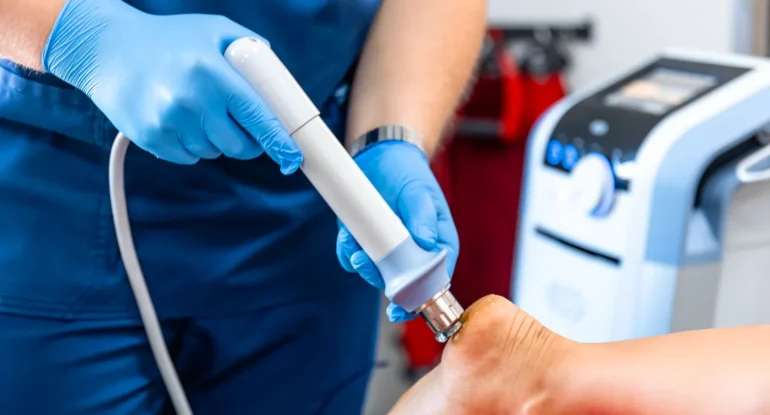13588 88 Ave #202, Surrey, BC V3W 2P5
Welcome to King George Physio!
-
Call for help: (604) 503-5682
-
Welcome to King George Physio!
Call for help: (604) 503-5682

Shock wave therapy—also known as extracorporeal shock wave therapy (ESWT)—has become a popular non-invasive treatment for chronic pain and musculoskeletal disorders. From treating plantar fasciitis and tennis elbow to shoulder calcifications and erectile dysfunction, ESWT is widely used across physiotherapy, orthopedics, and sports medicine.
But a common concern many patients have is:
“Can shock wave therapy cause damage?”
In this blog, we’ll break down how shock wave therapy works, the potential side effects, risks, safety concerns, and how to ensure you’re a good candidate for it.
Shock wave therapy uses high-energy acoustic waves to stimulate healing in affected soft tissues, tendons, or bones. It is commonly used in cases where conventional physiotherapy or medications haven’t worked.
There are two main types:
| Type of Shock Wave Therapy | Description |
|---|---|
| Focused Shock Wave Therapy | Delivers energy directly to a specific depth. Typically used for deeper tissues. |
| Radial Shock Wave Therapy | Disperses energy over a larger area. Often used for superficial muscle and tendon issues. |
While shock wave therapy is generally considered safe, there are instances where it may lead to mild side effects or temporary discomfort. However, permanent damage is rare, especially when administered by trained professionals.
– Mild bruising
– Swelling or redness in the treated area
– Temporary pain or tenderness
– Skin irritation or numbness
– Small tendon ruptures (in high-intensity cases)
– Minor bleeding under the skin
– Delayed healing if overused
– Pain worsens if used improperly or too frequently
These risks are minimal if proper protocols are followed and screening for contraindications is done in advance.
Read More Blogs: What Is Shock Wave Therapy in Physiotherapy?
No. Certain conditions or situations increase the risk of side effects or damage. You should avoid shock wave therapy if:
– You are pregnant
– You have a bleeding disorder or take blood thinners
– You have nerve or circulation disorders
– You have a pacemaker or metal implants near the treatment area
– You have cancer or tumors in the treatment region
– You have an infection or open wound in the target area
Here are ways to avoid potential damage:
| Tip | Why It Matters |
|---|---|
| Consult a certified physiotherapist or orthopedic specialist | Proper diagnosis ensures appropriate use of therapy |
| Limit the number of sessions | Too many sessions may cause tissue overload |
| Report any unusual symptoms immediately | Early intervention can prevent complications |
| Follow post-treatment instructions carefully | Helps tissues recover effectively |
Shock wave therapy is best for patients with chronic tendon injuries or persistent musculoskeletal pain who haven’t responded to other conservative treatments. It’s often recommended for:
– Plantar fasciitis
– Tennis elbow
– Achilles tendinopathy
– Shoulder calcific tendinitis
– Patellar tendinopathy
– Erectile dysfunction (low-intensity ESWT)
| Concern | Possibility | Preventable? |
|---|---|---|
| Skin irritation | Common | Yes |
| Temporary pain | Common | Yes |
| Internal bleeding | Rare | Yes |
| Tendon damage | Very Rare | Yes |
| Permanent damage | Extremely Rare | Yes |
In short: Shock wave therapy is safe when performed correctly. The chances of serious damage are very low, and most side effects are temporary and mild. If you’re considering ESWT, always seek treatment from a licensed physiotherapist and discuss your full medical history beforehand.
Some patients feel mild discomfort during treatment, but it’s generally tolerable and lasts only a few minutes.
Most side effects like redness or tenderness resolve within 24–48 hours.
Yes, there’s no downtime. You can resume daily activities immediately, but avoid strenuous exercise for a day or two.
Typically, 3–6 sessions are required, depending on the condition and severity.
In some cases, yes—especially if recommended by a physician for chronic conditions. Check with your provider.
Some patients feel mild discomfort during treatment, but it’s generally tolerable and lasts only a few minutes.
Most side effects like redness or tenderness resolve within 24–48 hours.
Yes, there’s no downtime. You can resume daily activities immediately, but avoid strenuous exercise for a day or two.
Typically, 3–6 sessions are required, depending on the condition and severity.
In some cases, yes—especially if recommended by a physician for chronic conditions. Check with your provider.